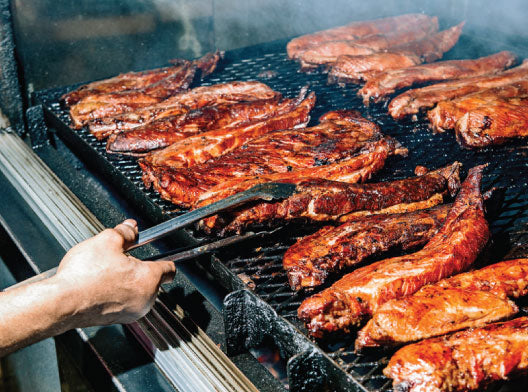- by Ben Del Coro
BBQ: The Art of Cooking with Fire
- by Ben Del Coro

BBQ began when a human ancestor, Homo erectus, cooked meat on a stick, sitting next to a fire about 1.8 million years ago. Despite these rudimentary origins, BBQ became more of a craft over time, as human civilizations evolved and developed ways to cook meat in pits underground, or on grates they built over fires.
The word “barbecue” is rooted in the language of the Taino, who once lived and thrived on the many islands we now know as the Caribbean. Their word for grilling on a raised wooden grate is barbacoa, which made its way to the Western world in 1526 through the publication of a Spanish explorer's account of the West Indies.
Today, there are many styles of BBQ across the world however, despite these different styles, BBQ is simply the art of cooking meat with fire and using the fire and, or, the smoke of the fire, to impart flavor.
Given the varieties of BBQ styles, there are equally as many methods to prepare BBQ. The basic principle is to season the meat well with the rub or sauce of your choice and manage the fire, or heat source, to do the rest. This is a slower cooking method that sometimes requires much more attention than other cooking methods because the temperature needs to be managed to stay consistent throughout the cooking process.
BBQ usually utilizes cuts of meat that benefit from a lower cooking temperature and longer cooking time. Depending on the cut of meat being cooked, cooking times can range from 6 to 24 hours, or more!
The choice of fuel for your fire is just as important as the choice of meat and seasoning, as different fuel types impart different flavors and intensity of heat.
Basic Rules to Good BBQ:
Start a fire and build a good bed of hot coals. Then, season a quality piece of meat, enter Fossil Farms, and put it over the heat source. Let the meat bathe in the low and slow heat and smoke of the fire for, well, as long as it takes!
Be sure to maintain your fire to produce an even cooking temperature of 200-275°F. Most thicker cuts of meat will cook evenly and internal temperatures will rise until they hit “the temperature stall”. The stall is caused by the evaporation of liquid on the meat's surface. This evaporative cooling works just like when you sweat while working hard. The stall can get frustrating because it lasts for hours. It's because the heating rate of the meat, and the temperature of the smoker, match the rate of evaporative cooling.
Does that mean that your meat will lose all of its moisture and turn into a dry hunk of yuck? No! The meat won't remain in the stall forever being that there is a finite amount of excess moisture available to be consumed when the meat is in this state. The rest of the moisture in the meat is tied up in the collagen, fat, and protein, where it will remain, creating that succulent "meat jello" that we all love. Once that excess moisture is used up, your meat should start raising in temperature once more. Thicker cuts of meat, such as brisket, shoulder butts, and ribs need to reach a minimum temperature of 175°F to break down the collagen and connective tissues.
BBQ is a game of patience and trust in knowing that you just can’t rush good BBQ. So, enjoy the process and give yourself plenty of time. The reward is worth the wait!
Share:
Searing Burgers to Juicy Perfection
Recipe, Cooking Tips & More